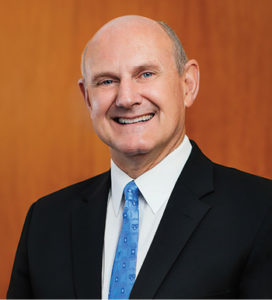
Dr. Mark Warner, APSF President.
The Anesthesia Patient Safety Foundation’s (APSF’s) vision statement is clear, “That no patient shall be harmed by anesthesia.” What does that mean, though? In the past, many anesthesia professionals, especially in the U.S., interpreted it to mean that no patients shall be harmed in the well-defined intraoperative period, plus perhaps in the immediate postoperative few hours when patients were in a postoperative care unit and their care was still somewhat the responsibility of anesthesia professionals. Does that simple interpretation still hold today as the definition and practice of anesthesia evolve?
We are increasingly aware that the impact of anesthesia extends well beyond operating rooms. For example, cognitive and immunologic impairments associated with the perioperative period can exist far beyond the time that we have an ability to measure the residual pharmacokinetics of any of our anesthetic medications. Our resolve that no patients shall be harmed and our subsequent actions in response to that resolve should now overlay many aspects of preoperative evaluation and management, the intense period of intraoperative and immediate postoperative care, and the prolonged postoperative period. Our expectations and those of our patients and health care colleagues are far different today than three decades ago when the APSF was started.
The APSF’s primary mission remains to continually improve the safety of patients during anesthetic care by encouraging and conducting:
- Safety research and education
- Patient safety programs and campaigns
- National and international exchanges of information and ideas
The mission has not changed. However, when applying the mission to today’s expectations of anesthesia professionals and trainees, APSF needs to ensure that its activities span the extended range of perioperative care and involve collaboration with the full spectrum of colleagues in all fields and industries that impact our patients’ care. There are important questions to be answered and issues to be addressed. Several of these involve changing behaviors and expectations of anesthesia professionals:
- Culture of Safety: Anesthesia professionals must support environments that allow all health care providers to speak out for patient safety. The “captain of the ship” ethos should be long gone and anesthesia professionals must be willing to be collegial but assertive in establishing a culture in which everyone is expected to contribute to the safety of patients.
- Clear Communications: Failure to effectively communicate is the primary factor in the majority of health care safety adverse events. Anesthesia professionals must take a lead in improving perioperative communications, including ensuring appropriate handoffs of care during the many transitions that occur during the perioperative period.
- Advocacy for Patient Safety: Anesthesia professionals must identify opportunities for improving patient safety and advocating for actions by their professional organizations and local facilities. For example, we know that increased monitoring can reduce the risk of postoperative opioid-induced ventilatory impairment but we have not consistently or effectively advocated for national or local practice guidelines that would address this potentially catastrophic issue. We have not presented a persuasive, coherent initiative that would propel industries and government agencies to develop less dangerous analgesics and better ventilatory monitoring. There are independent efforts but no coordinated strategies.
- Self-Improvement: Anesthesia professionals need to lead by example. Some of our daily practice patterns may contribute to patient harm. Drs. David Birnbach and Richard Prielipp led a fascinating APSF panel at the 2017 American Society of Anesthesiologists’ Annual Meeting on the impact of anesthesia professionals and the potential spread of infection during the intraoperative period. Adherence to optimal perioperative infection control practices will aid in improving patient safety. We can contribute to perioperative infections…and better practices may reduce that problem. We simply must continue to improve. Our patients can be harmed by our complacency.
The APSF has primarily been focused on the U.S. for the past several decades. This focus is changing to meet our founding mission to increase the international exchange of patient safety ideas. By the end of 2018, the APSF Newsletter will be published in multiple languages. These newsletter translations, along with translated safety videos, will appear on the APSF website (apsf.org) as they become available and will increase the exchange of ideas with an estimated 350,000 anesthesia professionals worldwide. Anesthesia patient safety must be a universal mission.
In the coming years, APSF will increase its focus on the full spectrum of perioperative safety issues and increase its advocacy for patient safety, even when it may not be popular. It’s the right thing to do for our patients…and for our profession.
Dr. Mark Warner is currently President of the APSF and the Annenberg Professor of Anesthesiology, Mayo Clinic, Rochester, MN.
Dr. Warner has no disclosures with regards to the content of the article.


 Issue PDF
Issue PDF